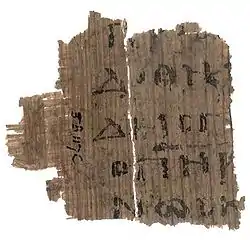Papyrus 70
Papyrus 70 (nach Gregory-Aland mit Sigel 70 bezeichnet) ist eine frühe griechische Abschrift des Neuen Testaments. Dieses Papyrusmanuskript des Matthäusevangeliums enthält nur die Verse 2,13–16; 2,22–3,1; 11,26–27; 12,4–5; 24,3–6; 24,12–15.[1]
| Papyrus 70 | |
|---|---|
 | |
| Name | P. Oxy. XXIV 2384 |
| Text | Matthäus 2,13–16; 2,22–3,1; 11,26–27; 12,4–5; 24,3–6; 24,12–15 |
| Sprache | griechisch |
| Datum | 3. Jahrhundert |
| Gefunden | Ägypten |
| Lagerort | Ashmolean Museum Archäologisches Nationalmuseum Florenz |
| Quelle | E. Lobel, C. H. Roberts, E. G. Turner, and J. W. B. Barns, OP XXIV (1957), S. 4–5. |
| Typ | Alexandrinischer Texttyp |
| Kategorie | I |
70 hat einen sehr zuverlässigen Text, obwohl er nachlässig geschrieben wurde. Mittels Paläographie wurde er auf das 3. Jahrhundert datiert.[2]
Text
Der griechische Text des Kodex repräsentiert den Alexandrinischen Texttyp. Kurt Aland beschreibt ihn als „strikten Text“ und ordnete ihn in Kategorie I ein.[1]
Aufbewahrungsort
Zurzeit wird das Manuskript im Ashmolean Museum (P. Oxy. 2384) in Oxford und am Papyrologischen Institut des Archäologischen Nationalmuseums Florenz aufbewahrt (CNR 419, 420).[1]
Einzelnachweise
- Kurt und Barbara Aland: Der Text des Neuen Testaments. Einführung in die wissenschaftlichen Ausgaben sowie in Theorie und Praxis der modernen Textkritik. Deutsche Bibelgesellschaft, Stuttgart 1989, S. 110. ISBN 3-438-06011-6
- Philip W. Comfort, Encountering the Manuscripts. An Introduction to New Testament Paleography & Textual Criticism, Broadman & Holman Publishers, Nashville, Tennessee 2005, S. 69.
Literatur
- Edgar Lobel, Colin H. Roberts, E. G. Turner, J. W. B. Barns: Oxyrhynchus Papyri. Band 24. London 1957, S. 4–5.
- M. Naldini; Nuovi frammenti del vangelo di Matteo. In: Prometeus 1 (1975), S. 195–200.
This article is issued from Wikipedia. The text is licensed under Creative Commons - Attribution - Sharealike. The authors of the article are listed here. Additional terms may apply for the media files, click on images to show image meta data.